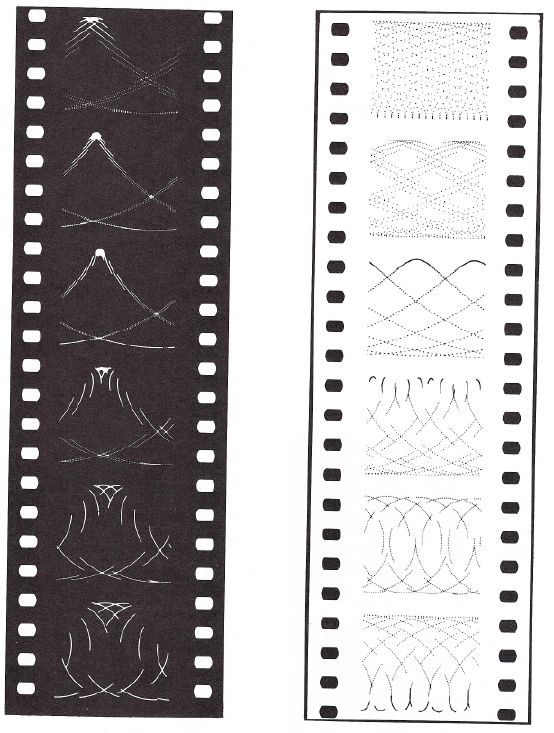JOHN WHITNEY
COMPUTATIONAL PERIODICS
We may assume that a time will come when that which I am about to describe will name itself—but for now: 'Computational periodics' is a propositional and tentative term which may help to designate a new unified field for a heterodimensional art; a field whose special dimension is time. An art which is temporal, as music itself; being, that is, spatio-temporal. An art whose time has come because of computer technology and an art which could not exist before the computer. Even though this art will be found in the notebooks of Leonardo and has been in the collective imagination, like the flying-machine, since his epoch it was a technological impossibility until the development of computer graphics.
Rhythm, meter, frequency, tonality and intensity are the periodic parameters of music. There is a similar group of parameters that set forth a picture domain as valid and fertile as the counterpoised domain of sound. This visual domain is defined by parameters which are also periodic. 'Computational periodics' then is a new term which is needed to identify and distinguish this multidimensional art for eye and ear that resides exclusively within computer technology. For notwithstanding man's historic efforts to bridge the two worlds of music and art through dance and theatre, the computer is his first instrument that can integrate and manipulate image and sound in a way that is as valid for visual, as it is for aural, perception.
That rare talent of the composer to create music which is self sustaining, i.e., the power of music to capture and hold our attention, is a sophisticated and subtle art which has been the exclusive gift of only a few composers in each of many past generations. It was a pedagogic skill, however, that a pupil might learn, provided he was himself possessed with latent genius. In this century all that pedagogy has been reduced to anxious uncertainty. The harmonic and metric traditions, for one thing, seem to be untranslatable into the new periodic resources that abound in computer technology. The body of knowledge that resulted, by the nineteenth century, in musical works of ponderous scale and proportion, is a lost art. By the standards of the Baroque era the present has retrogressed to infantilism.
The new composer, and the visual artist who may aspire to deal with teleonomic structures, could as well be the child of some early dark age. The Twentieth Century began with technology and has reaped a whirlwind of cultural dislocations and amnesia. Materials and forms and attitudes are so altered that past traditions are generally moribund.
Also from the point of view that this Century is but an episode in the life of human culture, it is clear that more paraphernalia of this epoch may be castoff than will survive into the next. Yet surely the computer will not. A solid state image storage system will replace the silver chemical ribbon and cinema will eventually be interred in the archival museum. But computer and computer graphics bring to mind the kind of tools that may characterize an age succeeding this century's age of the machine.
The computer is the coequal of the entire repertoire of musical instrumentation and heir to that domain of musical sound. At the same time, the computer is the ultimate kinetic image generative instrument. The kinetic image is in truth the creation of computer graphics since the cine or television camera is but a recording device and the hand-drawn image of motion is but a cartoon of motion.
Tatlin, Rodchenko, Gabo, Moholy-Nagy, Fontana, Duchamp, Kandinsky, Mondrian, Pollock and twice that many more artists of this century testify to the drive toward dynamic organization of energy and force in art. And toward ephemeralization of the art object in painting and sculpture. The past decade has seen that direction lead many artists to cinema, exotic technology and experiments with cybernetics. Yet it has passed generally unnoticed that this preoccupation of the last one hundred years has been toward a musicalization of visual art. For the urge to produce abstract architectonic structures that possess fluid transformability in visual space is no less than a grand aspiration toward music's double in the visible world. It is as a preoccupation with art in this exclusive sense that we may use the term computational periodics.
Pacific Palisades, California
November 1975

Some diverse harmonic caesura selected from the computer graphics material used in the film titled 'Arabesque', 1975.
Return to Table of Contents | Previous Section | Next Section

